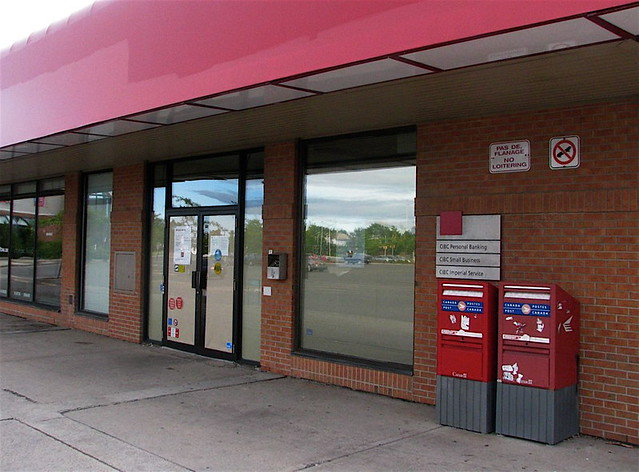
On Friday July 23, 2010, a signal change happened at the Fallingbrook Mall in Orléans: the local branch of the Canadian Imperial Bank of Commerce – CIBC – closed its doors for the last time.
Much of the furniture, the last of the files, and most of the signage had been moved out to other branches over the course of the previous few weeks. The final bits of equipment were moved out in rented vans the same evening the branch closed.
CIBC provided several months’ warning of this change to any and all willing to pay attention. To be sure, many of their customers at that branch will likely make use of the other branches further away from that mall. Many will also make use of the online services on offer, either supplanting or in addition to visiting those other branches. For these customers, it will be more or less business as usual with a minimum of discomfort or disruption. Some might not even feel any pain at all, and consider the change a “gain”.
CIBC, like the former Loeb Grocers – now operating as Metro – or Shoppers Drug Mart, was an anchor tenant at Fallingbrook from the day the mall opened in the latter half of the 1980’s. This change will have its consequences for the people of the Fallingbrook, Queenswood Heights and Avalon districts of Orléans; possibly a wider radius than that.
Spreading to the suburbs now, branch closures are part of a phenomenon that’s been hitting the rural communities of Canada for two decades, and in recent years many urban neighbourhoods as well. The banks have pulled out of hundreds of communities, in many cases severing ties that existed into for generations.
It’s a broader phenomenon than just banking of course. Lately an expression has been coined to describe a what happens when a neighbourhood loses all of its primary retail food sources, forcing the residents to either travel outside their neighbourhood or try to get by with convenience stores and their much higher prices. Such a district is called a “food desert“.
It remains to be seen if neighbourhoods that lose all of their storefront-level banking services will be known a “banking deserts”, but regardless of whether or not such a grim description is used, it’s worth considering that for many shopping centres and main streets, banks are anchor businesses, and when their customers go elsewhere or disappear into virtual realms, they take their reasons for shopping for other goods and service with them.
What of the empty space left behind? In the case of Fallingbrook, there is some doubt that CIBC’s competitors — should they even want to –would be able to set up shop in the abandoned location, as it may well be that CIBC’s lease with RioCan had a restrictive covenant preventing other banks from moving in to fill the gap.
We’ll close this entry by noting that there is a federal agency to which the public at large can make their views on specific bank openings and closures known: the Financial Consumer Agency of Canada.
photo by Dwight Williams


4 comments
It should be pointed out though that a new branch of the CIBC has opened at the corner of Trim Rd. and Innes Rd, in stand-alone building in the same complex as Sobeys. I would assume this is a direct replacement of the branch in the Fallingbrook Mall.
Based on the signage that CIBC left behind in the old location’s windows and doors, you’re correct on that “replacement” assumption.
Also, accuracy requires a clarification about the local competition: ScotiaBank still has a branch of their own in the neighbourhood at the mall across the street from Fallingbrook Mall.
I’m not sure how accurate the picture of the “banking desert” may be. Yes, banks were closing branches left, right, and centre in the 90s, but over the last five years there’s actually been a major push towards opening new branches. The branch closures were largely as a result of changes in banking patterns (i.e. the proliferation of ATMs making weekly trips to the teller obsolete), and the redistribution of population. Now bank branches are moving into areas that were previously underserved by banks (mostly suburbs that have popped up in the past 30 years).
An unrelated sidebar, yet also an update on this particular site: it’s been rented out for the duration of the 2011 federal election to the re-election campaign team backing Conservative Ottawa-Orléans MP Royal Galipeau.